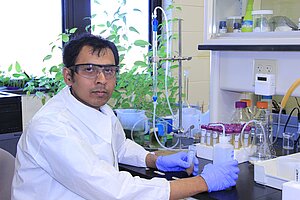Biopolymers for Phosphate Removal from Eutrophic Lakes

Mohammad Enayet Hossain is a Doctor of Philosophy (PhD) student in Environmental and Conservation Sciences program at North Dakota State University (NDSU). He received his MS in Soil Science and BS in Soil, Water and Environment from the University of Dhaka, Bangladesh. Before joining NDSU, Enayet worked as a faculty member in the Department of Soil, Water and Environment at the University of Dhaka and Chittagong University in Bangladesh. His NDWRRI-supported research is focused on the removal of phosphate from eutrophic lakes using biopolymers and reusing biopolymer-sorbed phosphate in agriculture.
Email: mohammad.e.hossain@my.ndsu.edu
Phone: 701-866-9317
Fellow: Mohammad Enayet Hossain
Advisor: Achintya Bezbaruah, PhD, Assistant Professor, Department of Civil and Environmental Engineering, North Dakota State University
Degree Progress: PhD in Environmental Sciences (Graduating in fall 2016)
Biopolymers for Phosphate Removal from Eutrophic Lakes
Phosphorus (P) is important for the growth of plants and microorganisms in most ecosystems. However, excess phosphorus present in aquatic bodies leads to the overgrowth of algae and plant species (an indicator of eutrophication of the waterbodies). While eutrophication is a natural process, it is accelerated through anthropogenic activities. Accelerated eutrophication not only impacts the aquatic life but indirectly hampers the economic progress of communities that rely on aquatic food and other resources. Dissolved phosphate as low as ~0.02 mg/L is known to cause profuse algal growth in waters, thereby posing a host of problems. Eutrophication of lakes is a major problem in North Dakota. According to the North Dakota Department of Health (NDDH), ~52% (87 lakes) are eutrophic and ~17% (29 lakes) are hypereutrophic among the lakes surveyed. Further, ~56% of the lakes are considered threatened indicating that the continuation of current water quality and/or watershed trends would make it unlikely that these waterbodies will continue to support aquatic life and the water will be fit for human uses. The amount of P-compounds in waters should be reduced to prevent eutrophication of lakes and other surface waters. It is imperative to devise effective methods to remove excessive phosphate from water and wastewater. Presently, there is a significant gap in technology to remove low concentration P from waters, specifically from eutrophic lakes. There is another aspect to the P issue. Phosphorus for fertilizer production is mined chiefly from select phosphate mines from Morocco, Western Saharan region, Peru, and China. The United States’ phosphate imports come from Morocco and Peru. Phosphorus is a nonrenewable resource and a recent assessment indicated that natural phosphate deposits will last for approximately 60-240 years. The present NDWRRI research involves the use of novel biopolymer beads for phosphate removal and reusing the beads (with sorbed phosphate) for agricultural purposes as source of phosphate for plants. The research, if successful, will provide a robust and sustainable technology (or technologies) to remove and recover aqueous phosphate.
Project Objectives:
The main objective of this research is to determine if biopolymer beads can be used to remove aqueous phosphate and then use the phosphate as a plant fertilizer. The specific objectives of this work are:
- To investigate the phosphate sorption characteristics of the beads
- To identify the sorption and desorption mechanisms
- To determine the feasibility of using the beads in eutrophic lakes
- To measure the bioavailability of bead removed P for agriculture uses
Significance:
This research work will enable us to alleviate the problem of eutrophication of lakes. In addition to dealing with eutrophication, this research will contribute towards generating a new source for phosphorus for agricultural uses and, thus, contribute towards better crop production in North Dakota and improve global food security.
Conference/Presentation:
EWRI presentation, June, 2014.
Hossain, M.E., Ritt, C., Bezbaruah, A.N. Iron Cross-linked Biopolymer for Aqueous Phosphate Removal, Surface Water Treatment Workshop, American Water Works Association, Fargo, North Dakota, April, 2014. (Poster)
Hossain, M.E., Ritt, C., Bezbaruah, A.N. Iron Cross-linked Biopolymer for Aqueous Phosphate Removal, North Dakota Water Quality Monitoring Conference, Bismarck State College and National Energy Center of Excellence, Bismarck, North Dakota, March, 2014. (Poster)
Hossain, M.E., Bezbaruah, A.N. Cross-linked Biopolymer Beads for Aqueous Phosphate Removal: Possible Application in Eutrophic Lakes, Eastern South Dakota Water Conference, South Dakota Water Resources Institute, Brookings, South Dakota, October, 2013. (Oral Presentation)

Achintya Bezbaruah
Civil & Environmental Eng.
Office: Civil/Ind Eng 201G
Telephone: 701-231-7461
Email: a.bezbaruah@ndsu.edu


